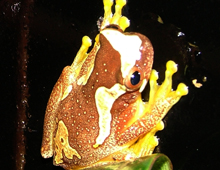Description: The back is yellow or yellowish tan and uniformly covered, although almost all have brown dorsal markings. These are highly variable in shape, but often take the form of an hourglass. The side of the head is mostly brown, with a distinct cream stripe on its upper lip which usually is expanded to a pale spot below the eye. Thighs uniformly pale orange or yellow, the upper arm, flanks, hands and feet pale yellow. The underside is cream and iris is reddish bronze. The snout is shortened in profile. An extensive axillary membrane extends almost to the elbow, the discs on the digits are relatively large and the toes about three quarters webbed, fingers about one half webbed.
Size: Males are 0.94 – 1.06 inches (2.4 – 2.7 cm) long and females 1.18 – 1.34 inches (3.0 – 3.4 cm).
Behavior: Hourglass tree frogs are nocturnal, arboreal frogs. They presumably spend most of their non-breeding time in forest trees and in bromeliads. During rainy season they call from low emergent vegetation at the edge of a pond, from dusk throughout most of the night.
Diet: They feed on insects.
Communication: These frogs can be quite noisy. Different calls are used for advertisement and aggression but usually include a primary note followed by clicks, with duration and frequency being quite variable.
Reproduction: During breeding season, males perform mating displays for the females – strutting and mating calls. Once the union is made, the female lays jelly-like masses of eggs on the surface of leaves that hang over the water’s edge and sometimes on the water’s edge itself. About five to seven days later, the eggs hatch and tiny gold tadpoles slide from the leaves into the water where they quickly grow and metamorphose into frogs. Once developed, the young frogs return to the trees.
Habitat/range: Hourglass tree frogs live high in the rainforest canopy for most of the year. During the rainy season, it descends to swamps and ponds in the rainforest for breeding. They are found from Mexico, down into northern South America.
Status: Listed as Least Concern by IUCN.



